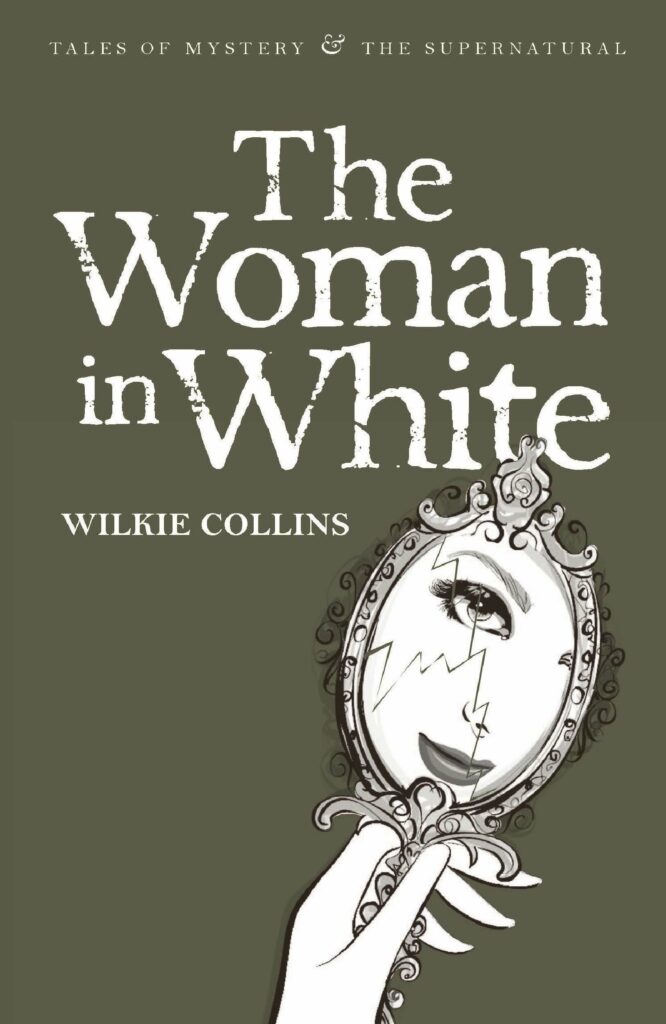
David Stuart Davies looks at the history of The Woman in White
In advance of the new BBC adaptation of ‘The Woman in White’ beginning on Sunday, David Stuart Davies looks at the history of the first ‘sensation’ novel.
The Woman in White was published in novel form in 1860, after being serialised in the magazine, All Year Round, and firmly established Wilkie Collins’ reputation with the reading public. It increased the magazine’s circulation dramatically and created such a sensation that the commercial world tapped into its success. There were women in White bonnets, women in White perfumes and all manner of toilet requisites. There were even a ‘Women in White Waltz’. A copy of the novel was to be seen in all the best households. Fellow novelist William Makepeace Thackeray was fascinated by the book; Gladstone found the story so absorbing that he missed a visit to the theatre in order to carry on reading it. Even Prince Albert read the book and recorded his approval. Quite simply The Woman in White was the literary sensation of the time and since its first publication, not only has it never been out of print but there have been numerous adaptations for the theatre, film and television – the latest being a BBC TV adaptation in 2018, featuring Jessie Buckley and Ben Hardy. There has even been a comic strip version. And, of course, it was the subject of a stage musical treatment by Andrew Lloyd Webber.
With the publication of the novel, Wilkie Collins found himself a star of the literary world. Despite his other brilliant works, including The Moonstone (1868), Collins himself regarded The Woman in White as his best novel. This is shown by the instructions he left in his will for the inscription to be placed on his simple headstone beneath his name: ‘Author of The Woman in White and other works of fiction.’
It was Collins’ friend and mentor Charles Dickens who commissioned him to write The Woman in White for his new magazine, All Year Round. It is to Collins’ great credit that the manacles of instalment writing – the need to reach a kind of cliffhanger situation at regular intervals in order to bring the readers back the following month – did not lead him to create a formulaic plot. The intricacies of the storyline line and the multi-voiced narration help to blur any sense of segmentation and homogenise the flow of the story. When reading the book today, the reader is seldom conscious of the episodic nature of its original presentation. Another reason for this is that Collins planned the novel meticulously.
The use of multiple narratives draws on Collins’ legal training and as he points out in his Preamble,
‘The story here presented will be told by more than one pen, as the story of an offence against the laws is told in Court by more than one witness.’ Therefore, Collins, with great facility, adopts the voice and tone of various characters and both sexes in carrying the reader along the path of the thrilling narrative.
Some of the basic details of the plot were borrowed from a collection of French criminal records bought by Collins in Paris while on a visit there with Dickens. Among these papers was a case involving the Marquise de Douhault who was drugged on a journey by her brother’s agents and imprisoned under a false name. Thus she was presumed dead and her scheming brother inherited her estate. After two years incarcerated in prison, the girl managed to smuggle a letter out to a close friend explaining her plight. The plot was uncovered and she was released. This account was the inspiration, the starting point if you like, for The Woman in White but the brilliance of the novel comes from Collins’ development of this simple scenario into a dark and labyrinthine plot with wonderfully dramatic moments and effective characterisations.
One of the most original aspects of the novel is the detective work carried out by Marian Halcombe and in particular the hero, Walter Hartright, who employs many of the sleuthing techniques of later fictional private investigators. On one occasion, in true detective hero fashion, Hartright jumps in a cab to lose his pursuers. It is all very Sherlock Holmes.
Very cleverly in constructing the plot of The Woman in White, Wilkie Collins gives us what critic Maurice Richardson regarded as ‘a double ration of everything.’ We have two heroines, two villains, and two great houses, Limmeridge and Blackwater. In the presentation of the two young women, Collins plays a clever hand by giving us first of all in Laura, the token Victorian heroine: fair-haired, blue-eyed, somewhat weak and malleable – a toy in the hands of the villains. In contrast, her devoted half-sister, Marian, was a revelation for the readers of the time. She is a tough, determined and feisty soul, in possession of atypical qualities of a leading lady in a Victorian novel and one might say that she was one of the first literary characters created by a man to strike a blow for the liberation of women.
The Woman is White is generally regarded as the first sensation novel, a term used to describe works of fiction with plots which typically included murder, bigamy, false identity, lunatic asylums, guilty secrets and premonitions. Sensation novels often feature a woman as the main protagonist, empowering them with resources, often violent, to challenge the dominance of the oppressive masculine world. Marian Halcombe is the archetypal heroine of the sensation novel. She is a far cry from the delicate and generally subservient heroines of Jane Austen’s novels and indeed some of the simpering lovelies who suffer in silence in a number of Dickens’ works.
The Woman in White remains an engrossing read. Although it makes its impact as an ingenious crime and suspense novel, simply to classify it in this way does not do full justice to the book. It is as Charles Knight, a contemporary critic reviewing the novel when it was first published, observed:
‘It is not the plot or the style which constitutes the fascination of this book. It is the full possession of… the power of throwing down… a hundred incidents which appear to be perfectly unconnected, and gradually gathering them together to produce the circumstantial or cumulative evidence which removes a veil from a great mystery.’
Books associated with this article
